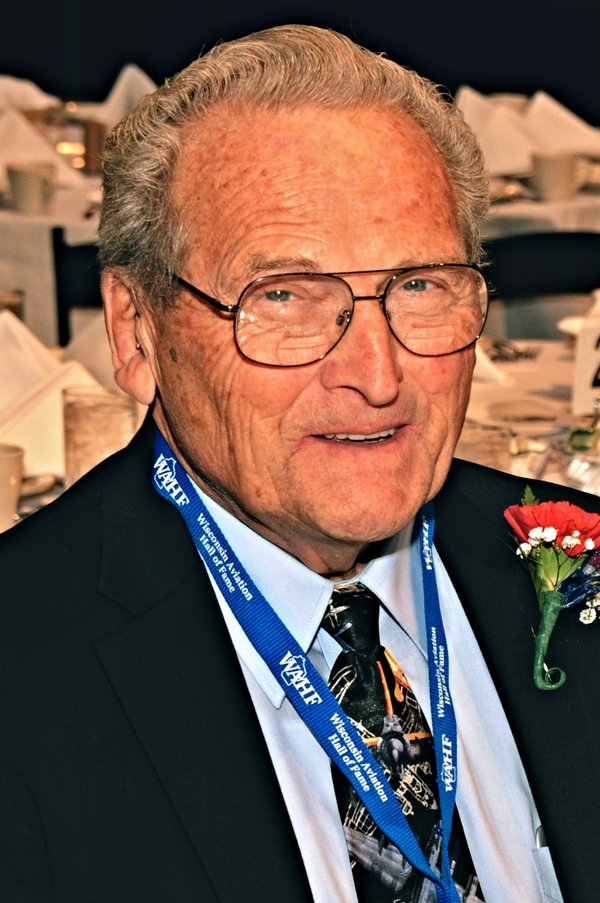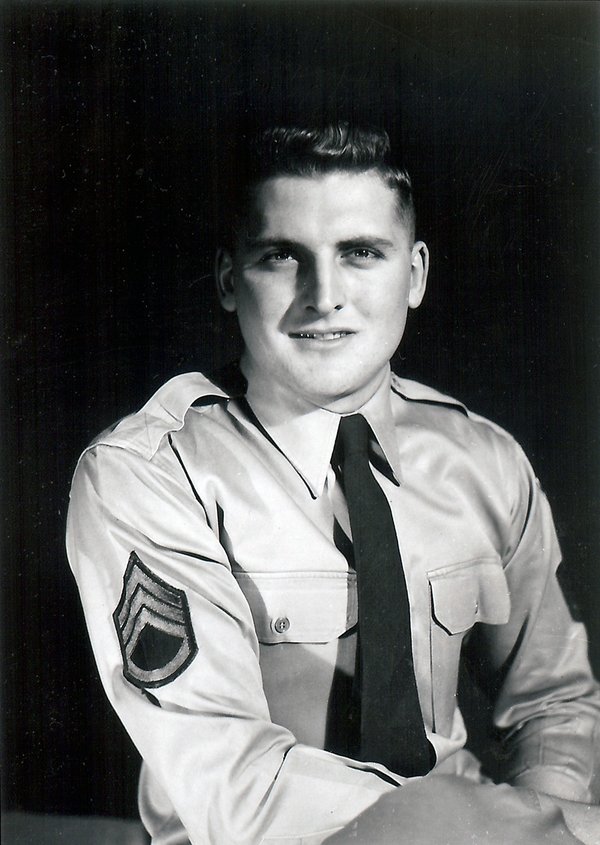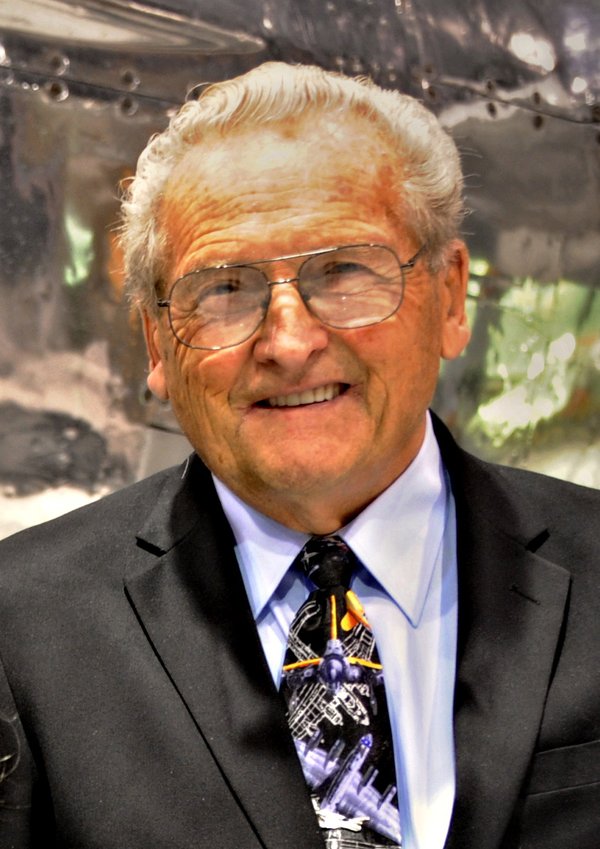
Darrel W. Gibson
Died: May 24, 2024
Inducted: 2015
Born in 1933 in Durand, Wisconsin, Darrel worked at his father's service station as a youth and learned that the travelling public comes to you for service and when the job's done right, they'll return. Darrel volunteered for the Army in February 1953, serving as a vehicle mechanic. In February 1955 he was honorably discharged as a Sergeant. He then spent a year and a half in Chicago at A&P School and also worked for United Airlines at Midway Airport.
In 1958 he went to work for badger Aviation in Eau Claire. By 1960 he was running the shop and fuel service. Darrel founded Gibson Aviation in 1961 and became the manager of Eau Claire's airport. Darrel was a Cessna and Piper dealer and offered charter flights. Line service, flight instruction, maintenance and sales were dependent on and assisted each other. Dedicated employees, his wife, and six children all contributed to its success.
Darrel's service as airport manager from 1961-1976 was demanding. In 1961, he assisted North Central Airlines' move into a new terminal building. In 1967, he oversaw taxiway, ILS, and Runway 4/22 extension projects. North central Airlines progressed from using DC-3s, Convair 340s and 580 propjets to DC-9s with eight flights a day. In 1976 they were at peak passenger loading. Keeping runways clear of snow and ice was a major concern. Darrel acquired the equipment needed for snow removal and mowing operations.
Darrel wrote the airport's certification, security, and crash rescue manuals. He and his employees took care of the terminal and airport maintenance and were on call at all hours. The city transferred airport ownership to Eau Claire County in 1979. Darrel was instrumental in the design and construction of the airport's new FBO facility in 1987. Gibson Aviation was sold in 1989, leaving a legacy that includes a son and grandson involved in aviation today.
DARREL GIBSON'S LEGACY
Gibson Aviation was a highway to the sky
By Jerry LeBarron
Published in Forward in Flight - Fall 2013
Most of us have had an involvement in or a passion for aviation, either past or present. Some of us become pilots, charter or purchase a new or used aircraft, or just stop in and hang out with our flying friends at airports. Some become aviation business owners, while others get into airport administration. One unique individual, Darrel Gibson, wore both hats, of fixed base operator and airport manager at the Eau Claire Municipal Airport.
Born in 1933 in Durand, Wisconsin, Darrel grew up working at his father’s service station where he learned that the traveling public comes to you for service and expertise and, if you do the job right and show concern, they will come back. One of the neighbors who lived next to his Dad’s service station was in the Army Air Corp in World War II. On one occasion when this particular neighbor came home on leave, he gave Darrel a ride in a Stearman, which fueled Darrel’s interest in aviation. This was a very exciting time period for Darrel, and coupled with his attending an air show at a young age, likely influenced Darrel’s future career in aviation. As a youngster, he built many airplane models and knew the names and specifications for all of them.
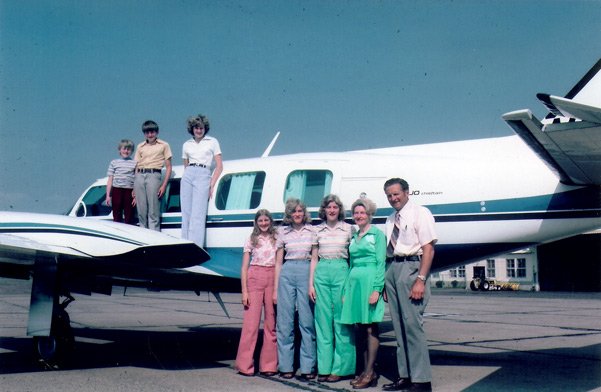
The Gibson family in about 1976 with Darrel’s Piper Navajo Chieftan. All of Darrel and Cleo’s six children worked at Gibson Aviation at one time or another through the years. From left to right, and youngest to oldest: Darren, Darrel, Donna, Patty, and twins Judy and Janet, with Mom and Dad on the right.
Even at an early age, Darrel lived on challenges. At the age of 9, he and his older sister Marge rode their bicycles from Durand to Stanley, Wisconsin, which is about 80 miles, to visit an aunt and cousins. The bicycles were only single speed, and the trip took 9 hours over hilly roads.
Around the time that Darrel graduated from high school in 1951, he took a few flying lessons at Schlosher Field in an Aeronca Champ. After graduation, he hitchhiked to Wyoming and took a summer job working at Yellowstone National Park. This job was short-lived, as he and his friend, Billy Wolf, heard they could make more money by going to Kalispell, Montana. So off they went, hitchhiking again, and for the rest of the summer, they worked clearing brush behind Hungry Horse Dam.
After returning from Montana, Darrel spent a year attending Stout State University in Menomonie, Wisconsin, and then attended vocational school in Eau Claire, taking machine shop courses. This all lead up to his volunteering for the Armed Services on February 20, 1953.
Darrel served from February 1953 through February 1955 in the 11th Army Calvary Division and was trained as a Wheeled Vehicle Mechanic. His duty stations included: Camp Carson in Colorado, Camp Irwin in California (including tank training), Fort Riley in Kansas, and finally Fort Knox, Kentucky. He worked his way to the rank of Sergeant and received an Honorable Discharge. Darrel also took some time off in late 1953 and married his lovely wife, Cleo, on December 28. Cleo was to become a significant part of Darrel’s early airplane projects and also the success of Gibson Aviation.
Back to Wisconsin
After the Army, Darrel and Cleo moved to Chicago so that Darrel could attend A & E (Airframe and Engine) school, located at Midway Airport. He attended school from 7:30 a.m. to 2 p.m. during the week and would then rush to get to his “real job” at United Airlines from 2:15 p.m. to 10 p.m. Cleo worked a full time schedule, as well. During his spare time, while in Chicago, Darrel completed his Private Pilot’s license and he and Cleo bought a 1948 Taylorcraft BC-12D for $500, which needed “some work”. Darrel tells the story of recovering and performing maintenance on the Taylorcraft with much help from Cleo, in their landlord’s garage. They made quite a mess in the garage (along with killing the landlord’s flowers) but the first test flight was a successful trip to Meigs Field. Their next trip was off to Durand, Wisconsin, to show the newly restored airplane to his parents.
After Darrel graduated from A & E school, the aviation job market was limited, especially if you wanted to live in an area where you could enjoy your “other” favorite hobbies like hunting and fishing. One place close to home and family that did offer both was the Champion Aircraft Company, in Osceola, Wisconsin, where they paid $2.50 an hour for welders. Darrel almost went to work for Champion. However, an offer came from Badger Aviation for $2.15 per hour that landed Darrel and Cleo in Eau Claire, Wisconsin, which turned out to be a good move.
The management at Badger Aviation quickly recognized Darrel’s mechanical abilities and he was placed in charge of the maintenance shop. His skills, determination, and honesty were also recognized by customers. After a year and a half of employment with Badger Aviation, the opportunity came about to purchase the FBO, along with an offer to become the Eau Claire Airport Manager. The year was 1961; Gibson Aviation Service was founded and open for business, and the Eau Claire City Airport had a new airport manager. Darrel was in his element and up for the challenge.
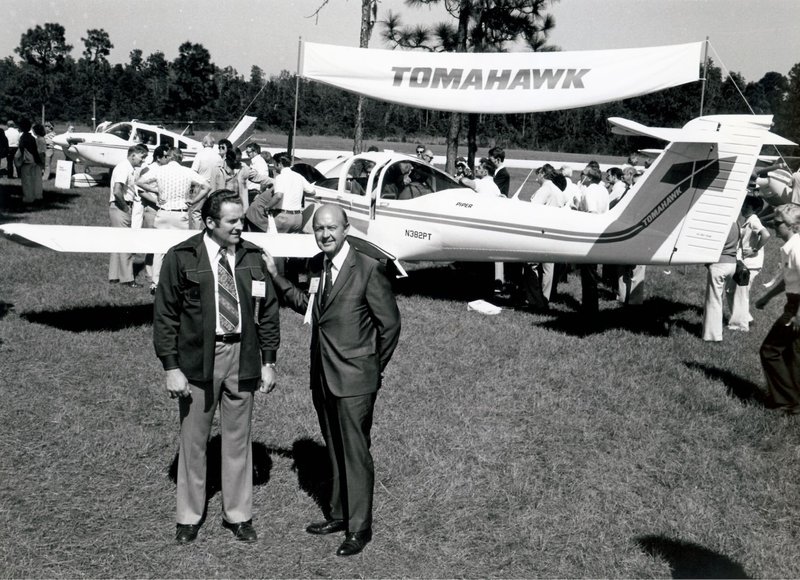
Darrel (on left) with Lynn Helms, then president of Piper Aircraft Corporation.
Gibson Aviation started with a Cessna 140 and a Cessna 172, providing flight training, charter service, and aircraft maintenance. During the early years, Darrel obtained his commercial, instrument, multi-engine, and Inspection Authorization ratings, and was active in all areas of the business. Darrel tells the story of renting instrument training manuals from Howard Morey in preparation for his instrument written exam. Charter service was always the backbone of operations at Gibson’s and the primary charter flight line consisted of twin Beeches, Cessna 310s, Piper Navajo Chieftains, Cessna 402s, and numerous Cessna and Piper single engine models.
In the early days, Darrel flew many of the charter flights himself, and continued to fly charters even when he employed a fulltime and part-time pilot staff. At one point, Gibson Aviation was operating five charters per night and had 25 Cessna and Piper aircraft on the flightline. For many years, Darrel utilized radio advertising to promote the business and there are still people in the Eau Claire area who remember the familiar jingle, “Fly Gibson Aviation, your highway in the sky.” By 1962, Darrel became a Cessna dealer; a Piper dealership was added in 1973.
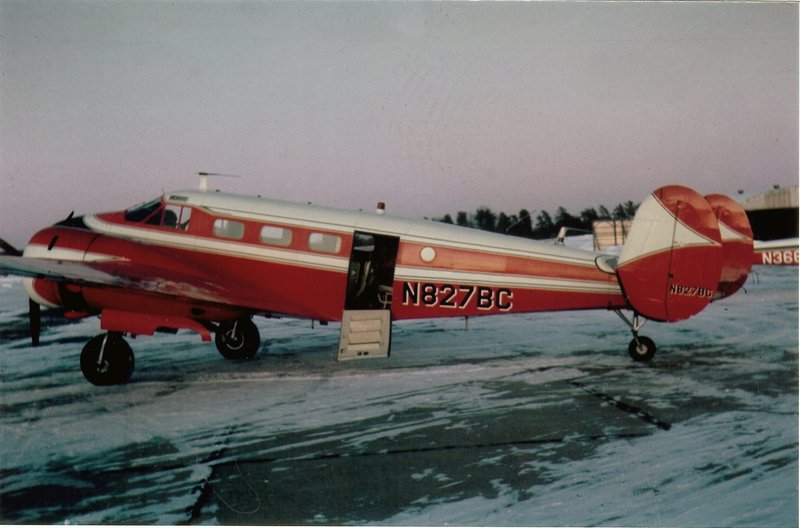
Darrel’s Beech 18, the second one he owned.
Although Darrel did not personally flight instruct, Gibson Aviation always offered flight instruction, employed a fulltime chief flight instructor, and was a VA-approved flight school. Darrel tells the story of when he was renting the Cessna 140 for $12 per hour, he got the idea that he could improve on rental revenue by lowering the cost, so he purchased an Aeronca Champ, and put it on the line for $6 per hour (wet). The reality was that renters preferred having an electrical system, and very few, if any, wanted to rent the Champ. If you were a flight instructor at Gibson’s, you got a little spoiled because you typically had the opportunity to fly new airplanes, as Darrel was both a Cessna and Piper dealer, and trainers were put on the line for sale after a few hundred hours. Cessna and Piper gave Darrel numerous sales and dealer awards. Gibson Aviation also leased single-engine aircraft to the State of Wisconsin and maintained them.
So Many Memories
Darrel likes to recount several stories of the early days and of memorable events and customers: Of course, for a charter pilot, flying in the Midwest means weather flying. Like the time on a trip to Chicago O’Hare, while filling in for Midstate Airlines with the Navajo Chieftain, following a snowstorm and having to hold 2.5 hours over Janesville, because there were only had two runways open at ORD. Then, there were the night flights from Winona, Minnesota, to Rochester, New York, flying boxes of radio harnesses for the auto industry at 13,000 ft. in icing conditions (and feeling sorry for the guys at lower altitudes picking up more ice).
In 1966, Darrel purchased a new Cessna 310K and installed the avionics, as he typically did with his new twin engine charter aircraft. At the time, a Cessna 310K cost $69,000. That same year, a Beech 55 was offered at a lower price, so Cessna lowered the 310’s price by $3,000. At this time, the airlines were on strike and Darrel was doing several regular charters out of Minneapolis. On one of those flights in the 310K, going non-stop to Washington National, one of the engines went to full rich approximately an hour out of his destination and he became concerned about his fuel reserve. When he landed at National he discovered the mixture control cable had separated just short of the fuel injection unit. The plane only had 95 hours on it. He was able to do a temporary repair and fly it back to Eau Claire and install a new cable. Darrel always felt that having a knowledge of mechanics was important when flying any aircraft.
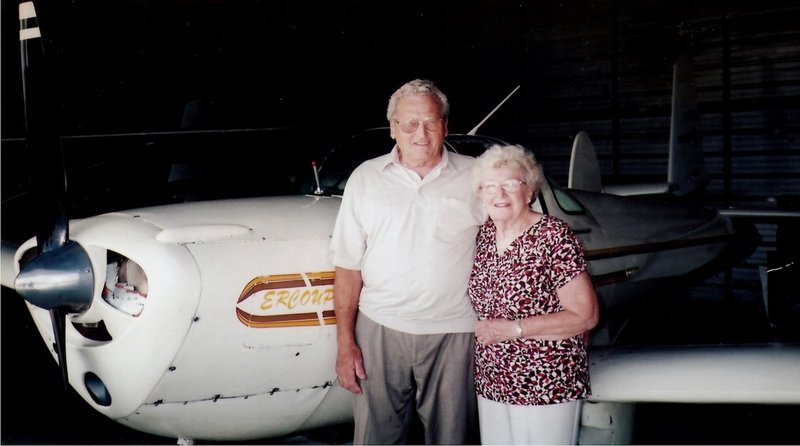
Darrel and Cleo in 2006 by the Ercoupe they own.
Darrel always made sure he knew where his airplanes were and that they kept flying safely. On one occasion, Darrel and Cleo were on a road trip visiting their twin daughters in Denver when Dan Daughty, who was flying a charter for Gibson’s, called Darrel. Dan was on a charter from Eau Claire to Phoenix and had stopped for fuel in Ratan, New Mexico. When Dan went to start the engines to leave, a starter had failed on one of the engines. Darrel immediately picked up a new starter from a Cessna dealer in Denver, drove it to Ratan, and installed it to get the aircraft to its destination.
Darrel always liked having extra fuel onboard and usually purchased his Cessna 310s with six tanks, approximately 200 gallons. One night he flew three passengers, along with his son Darrel Jr., to Fort Myers, Florida, nonstop, which took 7.5 hours. Another time he flew auto parts from LaCrosse to Brownsville, Texas, nonstop. One more reason Darrel liked to have ample fuel onboard was because he had a regular charter customer, for years, who would never tell Darrel where he wanted to go until they got in the air! These were the days before GPS… and these trips were to different destinations, which made for some interesting in-flight planning.
One summer, Darrel was weathered out of Eau Claire on three occasions with his twin Beechcraft and ended up at Minneapolis-St Paul International/Wold-Chamberlain Airport (KMSP). Back then, you could park on the south ramp of the main terminal and walk through a Northwest Airlines door to get to the main terminal.
“Can’t do that anymore,” Darrel says. Gibson Aviation also flew boxes of financial reports to Gate 67 at MSP, and the pilot, Jack Timm, would hand-distribute them to the individual airlines to be sent out.
Darrel commented, “You can’t do that anymore, either.”
Darrel has approximately 10,000 hours of flying time, most of which is time as a charter pilot. His favorite saying is: “I never left anyone up there”. Years ago, at an Eau Claire Chamber of Commerce dinner, Mr. John Jonas (then, the President of Sentry Insurance) was the speaker. He mentioned that he had flown with Darrel on numerous occasions and regularly utilized the services of Gibson Aviation, before Sentry had acquired their own airplanes. Hearing this from Mr. Jonas in front of a large local crowd made Darrel feel very proud.
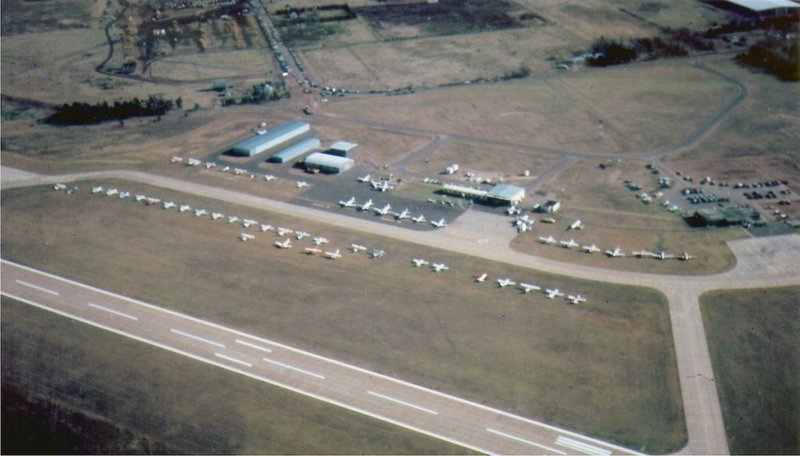
Gibson Aviation in the 1960s. The Eau Claire Flight Service Station is on the right.
Gibson Aviation played a significant role in promoting aviation and Eau Claire’s airport, and its value to the area. Every spring busloads of school kids would show up for the annual airport tours. At the end of the tour, all of the kids were given a balsa wood glider to take home. Then, there were the penny-a-pound airplane rides, usually held after the airshows (when the lines were long, Darrel could get nine passengers in the Beech18.)
Employees were often called upon to give talks on careers in aviation at the local schools and other functions. On occasion, the flight instructors would set up a table or booth at the student union building at UW-Eau Claire or at a local trade or sport show. These activities spawned more than one civilian, airline, or military pilot’s career.
One story shared by a former customer, Jim Anthony, summarizes Darrel’s personality as a cool, calm, and collected pilot. It goes as follows:
“It had been a long day. I had chartered with Gibson Aviation for a business trip and Darrel drew the short straw as the charted pilot. While it had been a beautiful day of VFR flying, night had settled in and we were on the final leg home. Just a few miles out, we hit a wall of unanticipated IFR weather. While Darrel was totally comfortable, I, as a strictly VFR pilot at the time, found the weather to be a bit unnerving. Nevertheless, I had settled back when there was a sudden, very loud “bang” and “shudder” that rippled through the plane. I was immediately at the edge of my seat attempting to find out what had just happened. I looked over at Darrel and was awestruck as he casually fished around in the dark and found a flashlight. He pointed the flashlight at the windscreen and switched it on. The windscreen was totally covered in a thick coat of blood, feathers, and goose remains. Equally as casually, he switched the flashlight off, returned it to the floor, and turned to me to say, “I believe we hit something.” Before I could regain my wits, Darrel had intercepted the ILS and safely landed the plane.”
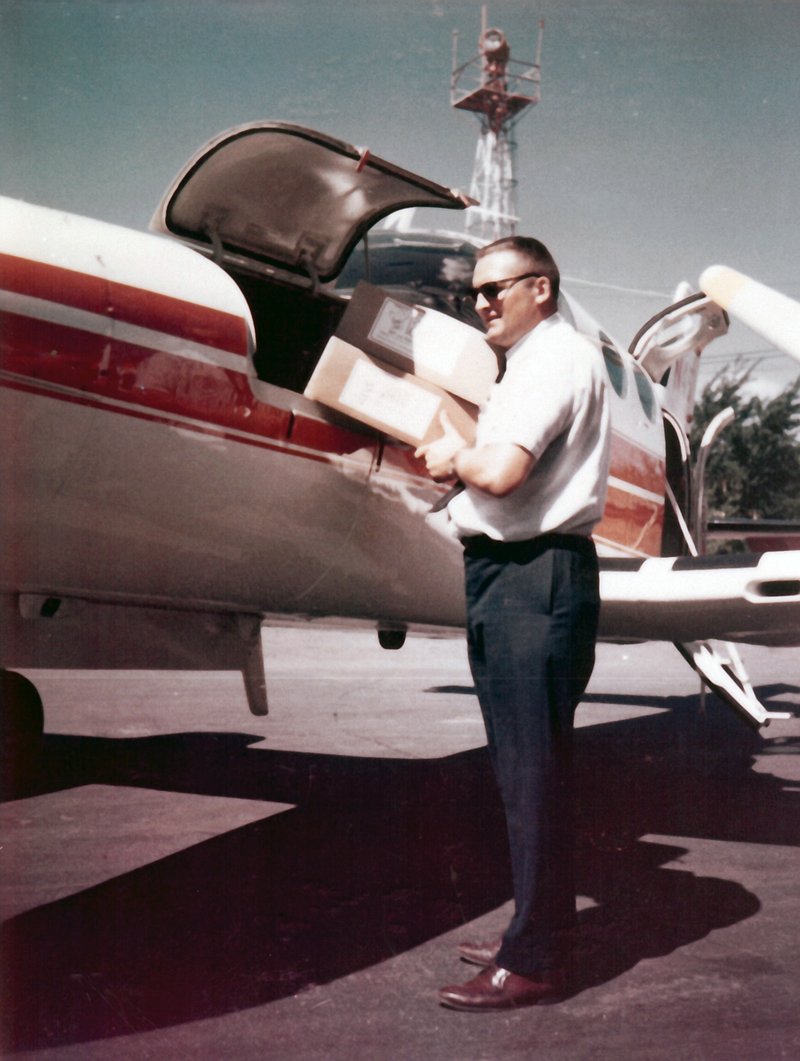
Charter and cargo flights in a Cessna 402 were a big part of Gibson’s business in the late 1960s. Ca. 1969.
Jim is now an experienced pilot himself, and flies his own Cessna 421 and Pitts biplane. When Jim was just 5, he took his first flight in the baggage compartment of a Cessna 150 with his father, Dale Anthony, who was on an introductory flight with Darrel at the controls. Both of Jim’s parents learned to fly at Gibson Aviation.
A modern Gibson Aviation FBO facility was built in 1988. The original Quonset hut that housed the lobby, offices, and pilot’s lounge (and many memories), was demolished, while the maintenance hangar was disassembled and given to the Civil Air Patrol. Darrel owned Gibson Aviation from 1961 – 1989.
Airport Management
Darrel was also the airport manager at Eau Claire Municipal Airport (KEAU) from 1961 – 1976. The Eau Claire airport was formally opened on the afternoon of July 29, 1945, with then State Senator Warren Knowles of New Richmond giving the principal address. The Eau Claire Airport continued to grow and serve the Eau Claire area throughout the years, while many significant milestones were accomplished during Darrel’s tenure. Some of those milestones included: assisting North Central Airline’s move into the new airline terminal building in 1961, overseeing the extension of Runways 4 and 22 from 4,300 feet to 7,300 feet, along with taxiway expansion, writing manuals for airport certification, security, crash rescue, fencing, etc.; overseeing the installation of the ILS system and airport lighting systems; and acquiring military surplus equipment for airport maintenance use.
While Darrel was airport manager, for an approximate 15-year period, Gibson Aviation provided all of the airport mowing and snow removal. This came about because of the lack of available City funding and the requirement for immediate snow removal capability to keep the airport open for scheduled airline and unscheduled service. To meet this requirement, Darrel, on his own, purchased the required snow removal and mowing equipment (Government surplus), modified it to meet the airport requirements, and provided the service back to the city at an hourly rate. Gibson Aviation also provided seven-day-a-week terminal and airport maintenance service at the airport. This capability and service was a significant savings to the City of Eau Claire. The stories from these efforts alone could fill a book.
During this time, Darrel witnessed and supported a major transition of North Central Airlines with regard to passenger service at the Eau Claire Municipal Airport. Service evolved from DC-3s and Convair 440s evolving to 580 prop jets and to the DC-9s. This included eight North Central flights a day, starting a 6:30 a.m. with the last flight at midnight, with North Central having a peak-year in Eau Claire in 1976. During this period, Midstate Airlines also had scheduled service into Eau Claire with their Beachcraft 99s. In addition, SMB Stage Lines based a Hamilton-Westwind turbine conversion Beach 18 on Gibson’s ramp, that flew the nightly mail. All of this activity (not to mention the daily transient/corporate traffic) made for a busy ramp at EAU, all of which Gibson Aviation supported.
Darrel gave up the airport manager position in 1976, and the Eau Claire airport was transferred to Eau Claire County. He played a big part in supporting and preparing for the first Eau Claire Jaycees’ Airshow – Upward 76, which featured the Blue Angles. The airshow at Eau Claire, featuring the Blue Angels, has been a scheduled event every other year since.
A fact of working at Gibson Aviation was that you typically got involved with most anything that needed to be taken care of and Darrel was no exception. An early article written on Darrel by Walter R. Conner of the Eau Claire area Civil Air Patrol, told of how “through the years you could observe Darrel doing any of the following: sweeping or scrubbing a dirty shop floor, chipping ice around a frozen hangar door, lying under a truck or airplane repairing a major or minor problem, in a snow plow clearing a runway, changing a beacon bulb, fixing runway lights, or flying a charter in a single or multi-engine aircraft.” Darrel’s philosophy is that “you should be able to do anything that you asked an employee to do.”
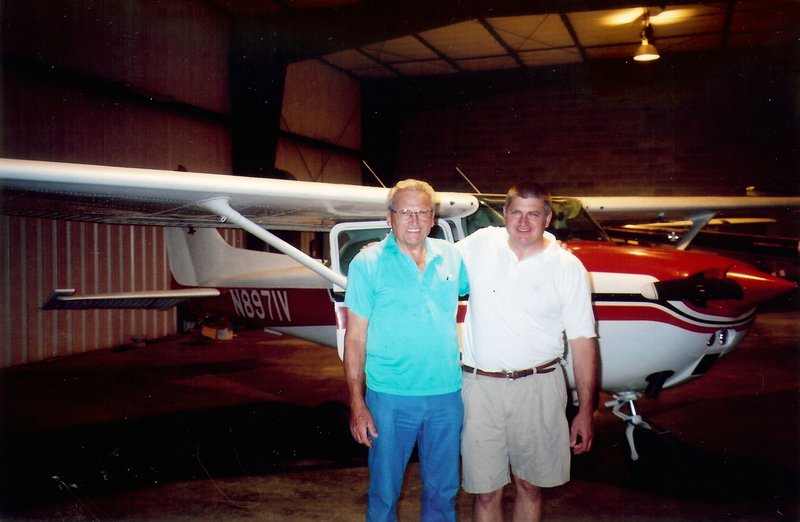
Darrel Gibson Sr., left, with Darrel Gibson, Jr. Gibson Aviation Services continues today with Darrel Jr. at the helm at Menomonie Municipal Airport-Score Field (KLUM).
Darrel had—and still has—the reputation of always wanting to fix and improve things. One of the of locals told us that you never had to be afraid of buying anything from Darrel as it was always better than when Darrel bought it.
Darrel and Cleo raised six children (four girls and two boys) who were all involved in the family business while growing up. After school, on the weekends, as well as during summer vacation, you would see them working their designated jobs at the airport. While the kids are now grown and enjoying their families and careers, they have given Darrel and Cleo the joy of 13 grandchildren. One of the boys, Darrel Jr., has stayed in aviation and carries on the Gibson Aviation name. Darrel Jr. is the Airport Manager and FBO (appropriately named Gibson Aviation Services LLC) at the Menomonie Municipal Airport—Score Field (KLUM) and also owns and operates St. Croix Valley Aviation at L.O. Simenstad Municipal Airport (KOEO) in Osceola, Wisconsin.
Since 1989
So, what has Darrel been up to since selling the FBO? Shortly after retiring, Darrel flew with Jake Walker for Excel Energy for a few months. One of Darrel’s longtime hobbies, along with airplanes, is boats. Darrel has built a few airboats, and he and Cleo also purchased a 54-foot cruiser in Page, Arizona, and then made trips to Page for a few months to restore it. They then escorted it to Lake Superior and spent many years enjoying it with their family. Darrel still flies routinely and has purchased, restored (always making them better), and sold, numerous airplanes. Darrel told some interesting post retirement stories with regard to acquiring aircraft: Darrel had purchased a Cessna 152 in Alaska and he and Cleo went to Alaska to fly it back. They flew three legs per day for a total of 9 hours per day for a three day total of 27 hours (which did not include staying in hotels). Darrel wanted to fly a direct route and Cleo wanted to fly the highways… Darrel said (with a smile) “they compromised.” He also earned a seaplane rating and purchased a Lake Amphibian, which he restored and eventually sold. It seems like the only trips he and Cleo made in the Lake were to Lake Wissota and back to EAU (maybe 10 miles).
Darrel and Cleo’s latest venture is the resort business. He and Cleo are the proud owners of Shady Elms Resort at Mikona on Red Cedar Lake, near Rice Lake, Wisconsin. They are restoring the site, and its 1906-vintage buildings, back to their original state. Darrel can also be found a couple times a week at Gibson Aviation in Menomonie, helping out Darrel Jr. in the shop with.
Darrel and Cleo are both 80 years “young”. They still live in the house they built in 1967, which is close to Eau Claire airport, and enjoy time with all of their children and grandkids, along with keeping very active with their projects.
While Cleo and Darrel were being interviewed for this article, Darrel Jr. came into the conference room we were using and the airframe logbook of a particular 1961 Cessna 182 that he was performing an annual on that day. Darrel Jr. turned to the first page of the airframe log and showed the first entry. The aircraft was sold new by Darrel Sr. and the first entry in the logbook was also made by Darrel Sr.
The legacy of Gibson Aviation continues.
